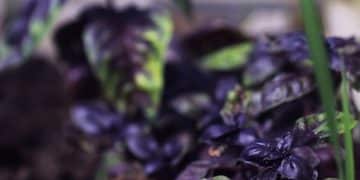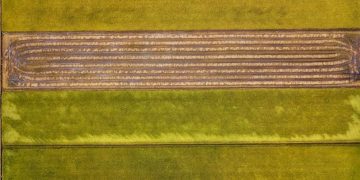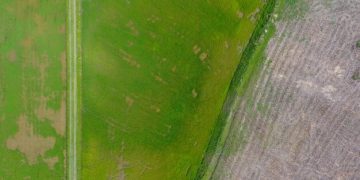Nanotechnology in Agriculture: Enhancing Crop Quality and Nutrient Delivery

Nanotechnology in agriculture offers groundbreaking solutions for enhancing nutrient delivery and improving crop quality by utilizing nanoscale materials to optimize plant health and productivity with precision.
Agriculture is constantly evolving and looking for innovative ways to boost yields and crop quality. The Role of Nanotechnology in Agriculture: Enhancing Nutrient Delivery and Improving Crop Quality has emerged as a promising field, offering solutions at the nanoscale to optimize plant health and productivity.
What is Nanotechnology in Agriculture?
Nanotechnology involves the manipulation of matter at the atomic and molecular level. In agriculture, this translates to using nanomaterials to improve various aspects of crop production. This includes enhancing nutrient uptake, disease detection, and overall plant health.
Let’s dive deeper into how nanotechnology is reshaping the agricultural landscape.
Enhanced Nutrient Uptake
Traditional fertilizers often suffer from inefficiencies, with a significant portion being lost to runoff or conversion into unusable forms. Nanotechnology offers a solution by encapsulating nutrients in nanoparticles, allowing for controlled and targeted release. This reduces waste and ensures that plants receive the nutrients they need, precisely when and where they need them.
Precision Farming
Nanotechnology enables precision farming by providing sensors that can detect plant stress, nutrient deficiencies, and diseases at an early stage. These nanosensors can be deployed in the soil or sprayed on plant leaves, providing real-time data to farmers. This allows for timely interventions, such as targeted application of fertilizers and pesticides, optimizing resource use and minimizing environmental impact.
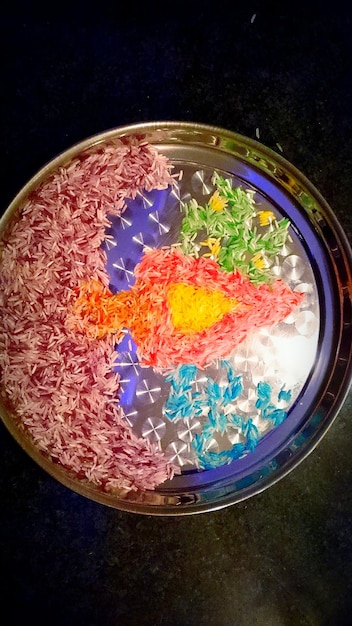
Consider the following benefits:
- Improved nutrient use efficiency reduces the need for excessive fertilization.
- Reduced environmental impact by minimizing nutrient runoff and pollution.
- Enhanced crop yields through optimized nutrient delivery.
In summary, nanotechnology offers farmers tools to manage their crops more efficiently and sustainably by using less resources and reducing the environmental impact.
Nanoparticles for Improved Crop Quality
Beyond nutrient delivery, nanotechnology plays a crucial role in enhancing the overall quality of crops. Nanoparticles can be used to improve traits like size, color, taste, and nutritional content.
Here’s a look at how nanotechnology contributes to better crop quality.
Disease Detection and Management
Early detection of plant diseases is critical for preventing widespread crop losses. Nanosensors can detect disease biomarkers at concentrations, allowing farmers to identify and address problems before they escalate. Furthermore, nanoparticles with antimicrobial properties can be used to control plant pathogens, reducing the need for chemical sprays.
Stress Tolerance
Crops often face various environmental stresses, such as drought, salinity, and extreme temperatures. Nanoparticles can enhance plant tolerance to these stresses by improving water uptake, reducing oxidative stress, and fortifying plant defenses. This contributes to more resilient and productive crops, even under adverse conditions.
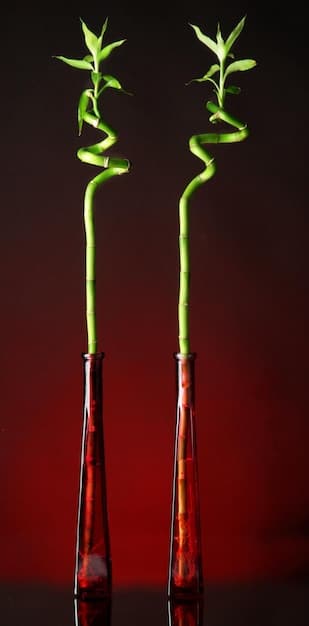
Consider these points:
- Enhancement of crop traits, such as fruit size, color, and nutritional content.
- Improved disease resistance, leading to reduced crop losses and fewer pesticide applications.
- Increased stress tolerance, ensuring stable yields even in challenging environments.
- Better shelf life and post-harvest quality, reducing food waste.
In conclusion, nanotechnology not only boosts productivity but also improves the overall health and quality of crops, guaranteeing better yields and nutrition for consumers.
The Role of Nanofertilizers
Nanofertilizers are one of the most promising applications of nanotechnology in agriculture. These fertilizers are designed to release nutrients in a controlled manner, ensuring that plants receive the right amount of nutrients at the right time.
Here’s what makes nanofertilizers a game-changer.
Controlled Release
Traditional fertilizers often release nutrients rapidly, leading to losses through leaching and volatilization. Nanofertilizers, on the other hand, encapsulate nutrients within nanoparticles, allowing for slow and sustained release. This ensures a continuous supply of nutrients to plants, improving nutrient use efficiency and reducing environmental impact.
Targeted Delivery
Nanofertilizers can be designed to target specific plant tissues or cellular compartments, maximizing nutrient uptake and minimizing waste. This targeted delivery is particularly useful for micronutrients, which are essential for plant growth but often required in very small amounts.
The advantages are clear:
- Increased nutrient use efficiency, reducing the amount of fertilizer needed.
- Reduced nutrient losses, minimizing environmental pollution.
- Optimized plant growth, resulting in higher yields and better crop quality.
In closing, nanofertilizers are a novel solution that tackles inefficiencies and environmental concerns related to traditional fertilizer use.
Nanosensors for Plant Health Monitoring
Nanosensors are revolutionizing plant health monitoring by providing real-time data on plant physiology, nutrient status, and disease incidence. These sensors can be deployed in the soil, on plant surfaces, or even within plant tissues.
Let’s examine the role nanosensors play in modern agriculture.
Real-Time Data
Nanosensors can continuously monitor various parameters, such as soil moisture, pH, nutrient levels, and the presence of pathogens. This real-time data enables farmers to identify problems early and take corrective action before they escalate.
Early Disease Detection
Nanosensors can detect disease biomarkers at concentrations, allowing farmers to identify infected plants at an early stage. This enables targeted treatment, preventing the spread of disease and reducing crop losses.
Key benefits include:
- Timely detection of plant stress and nutrient deficiencies.
- Precise irrigation and fertilization, optimizing resource use.
- Reduced pesticide applications, minimizing environmental impact.
Ultimately, nanosensors equip farmers with necessary information to better manage their crops, promoting sustainability and efficiency in agriculture.
Challenges and Considerations
While nanotechnology holds immense potential for agriculture, there are also challenges and considerations that need to be addressed. These include the potential toxicity of nanoparticles, their environmental fate, and the regulatory framework governing their use.
Here are some of the key challenges.
Toxicity Concerns
Some nanoparticles have been shown to be toxic to plants, animals, and humans. It is essential to conduct thorough toxicity assessments to ensure that nanomaterials used in agriculture are safe and do not pose any health risks.
Environmental Impact
The environmental fate of nanoparticles is not yet fully understood. There are concerns about their potential accumulation in soils and water bodies, as well as their effects on soil microorganisms and other non-target organisms. Comprehensive environmental risk assessments are needed to ensure sustainable use of nanotechnology in agriculture.
Important factors to consider:
- Thorough toxicity testing to ensure the safety of nanomaterials.
- Environmental risk assessments to evaluate their potential impact on ecosystems.
- Regulatory frameworks to govern the safe and responsible use of nanotechnology in agriculture.
In summary, while nanotechnology has great promise, cautious and informed implementation is vital for long-term sustainability and safety.
Future Trends in Nanotechnology for Agriculture
The field of nanotechnology in agriculture is rapidly evolving, with new applications and innovations emerging all the time. Future trends include the development of smart delivery systems, nano-enabled sensors, and advanced materials for crop protection.
Here’s a glimpse into what the future holds.
Smart Delivery Systems
Future delivery systems will be able to respond to environmental stimuli, such as temperature, pH, and light, releasing nutrients and pesticides only when needed. This will further reduce waste and minimize environmental impact.
Advanced crop protection
Nanomaterials can be used to create protective coatings for seeds and plant leaves, shielding them from pests, diseases, and environmental stresses. These coatings can also enhance water retention and nutrient uptake, further improving plant health and productivity.
Upcoming advances will focus on:
- Development of stimuli-responsive delivery systems.
- Integration of nanosensors and data analytics for precision farming.
- Use of nanomaterials for enhanced crop protection and stress tolerance.
To conclude, nanotechnology will continue to reshape agriculture, leading to more sustainable, efficient, and productive farming practices.
| Key Point | Brief Description |
|---|---|
| 🌱 Enhanced Nutrient Delivery | Nanoparticles encapsulate and deliver nutrients directly to plants. |
| 🔬 Nanosensors | Real-time monitoring of plant health and environmental conditions. |
| 🛡️ Disease Management | Early disease detection and targeted treatment using nanomaterials. |
| 🌍 Environmental Impact | Reducing waste and optimizing resource use for sustainable farming. |
Q&A
▼
Nanotechnology improves nutrient delivery by encapsulating nutrients in nanoparticles, allowing for controlled release and targeted delivery to plant tissues, thereby maximizing nutrient uptake and reducing waste.
▼
Nanofertilizers are fertilizers made with nanoparticles that release nutrients in a controlled manner, enhancing nutrient use efficiency, minimizing nutrient losses, and optimizing plant growth for higher yields and better crop quality.
▼
Nanosensors provide real-time data on plant health, soil conditions, and disease incidence, enabling farmers to detect problems early, optimize resource use, reduce pesticide applications, and promote sustainable farming practices.
▼
The challenges include potential toxicity of nanoparticles to plants, animals, and humans, as well as concerns about their environmental impact, necessitating thorough toxicity assessments, environmental risk evaluations, and regulatory frameworks.
▼
Future trends encompass smart delivery systems responding to environmental stimuli, integration of nanosensors with data analytics for precision farming, and use of nanomaterials for advanced crop protection and enhanced stress tolerance.
Conclusion
The role of nanotechnology in agriculture: enhancing nutrient delivery and improving crop quality represents a paradigm shift in how we approach food production. By addressing inefficiencies in nutrient use, enabling early disease detection, and enhancing stress tolerance, nanotechnology promises to boost yields and promote environmental sustainability. While challenges remain, the potential benefits are undeniable.
